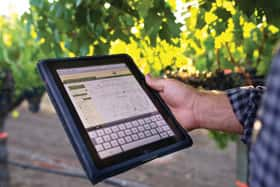Modern Marvel
The January 2016 issue of Wired magazine reported that Palmaz Vineyards in Napa is using the  Fermentation Intelligence Logic Control System, a proprietary technology created by Christian Palmaz, which lets winery staff track the health and progress of wine fermenting in tanks. The system is utilizes a state of the art thermographic image processor and a technology called sono-densitometry, tech found in submarine-industry technology.
Fermentation Intelligence Logic Control System, a proprietary technology created by Christian Palmaz, which lets winery staff track the health and progress of wine fermenting in tanks. The system is utilizes a state of the art thermographic image processor and a technology called sono-densitometry, tech found in submarine-industry technology.
Palmaz Vineyards’ gravity-flow and gravity-finish subterranean winery is a remarkable feat of engineering that fuses tradition and technology to produce world-class vintages. The winery is built into an 18-story cavern in the flank of Mount George, providing it with all the benefits of gravity-flow winemaking as well as the natural temperature control of a cave. By eliminating mechanical pumps from the winemaking process, gravity-flow design minimizes the turbulence that damages wines’ molecular structure.
At the heart of the winery sits the fermentation dome, lined with 24 fermentation tanks that can accommodate grapes from individual vineyards across the estate. The sophisticated monitoring systems for each tank lets winery team members project a broad range of data (including thermal imaging) onto the ceiling of the dome, while vibrating probes within each tank tell winemakers what the density (and, thus, the sugar content) of the juice is.
In addition to producing world-class wine, Palmaz Vineyards is net-zero water consumptive, meaning all water used throughout the process of winemaking is treated to nearly potable standards and used 100 percent for irrigation the following year.
Wastewater Solutions
 Growing compliance efforts on behalf of national dairy agencies are upholding stricter regulations on the quality of discharged dairy water. Typically high in nutrients, the wastewater isn’t fit for reuse for fear of oversaturating the ground in nutrients, smothering crops. Headquartered in Santiago, Chile, BioFiltro created a solution by using natural means to filter and extract excess nutrients, allowing dairies to recycle their discharge for watering and feeding livestock.
Growing compliance efforts on behalf of national dairy agencies are upholding stricter regulations on the quality of discharged dairy water. Typically high in nutrients, the wastewater isn’t fit for reuse for fear of oversaturating the ground in nutrients, smothering crops. Headquartered in Santiago, Chile, BioFiltro created a solution by using natural means to filter and extract excess nutrients, allowing dairies to recycle their discharge for watering and feeding livestock.
Biofiltro systems use a four-step process: First, solids are separated from the water through a screen. Earthworms are then introduced to the wastewater. The worms eat through pollutants and they contain bacteria helpful in eliminating contaminants. After the worms clean the water, it is filtered twice more, first through wood, then through gravel. The recovered water is significantly reduced in contaminants and safe for reuse. The leftover worms can be used as fertilizer.
Already used in the dairy business, BioFiltro can also work for wineries, using winery-discharged water instead of dairy.
Advanced Vineyard Monitoring
With California’s drought still occupying many people’s thoughts, Fruition Sciences’ system for measuring  how much water a vine really needs is attracting a lot of attention. Key products include the company’s specific software, sap flow sensors and yield mapping.
how much water a vine really needs is attracting a lot of attention. Key products include the company’s specific software, sap flow sensors and yield mapping.
The software integrates and connects all vineyard information, facilitates data and builds a history for the comparison of vintages. Sap flow sensors are installed directly on the vine and continuously monitor vine transpiration to help manage irrigation, while the yield mapping scans vines, row after row, using a geotagged laser beam on an ATV, before the vines are pruned. It measures shoot diameter, number of shoots per vine and average biomass, then generates maps to assess vine balance. This serves to map wood growth and minimize vineyard variations.
Started in 2007, the company has 11 full time employees and offices in Oakland, St. Helena and France. Its monitoring service currently keeps tabs on more than 1,000 vineyards across the US, France, Italy, Portugal, Argentina, Chile and China, spanning many different grape varieties, climates and terroir.



